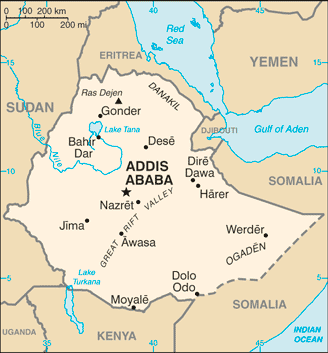The country of the Horn of Africa is currently battling outbreaks in two vaccine-preventable diseases, according to the United Nations Office for the Coordination of Humanitarian Affairs (OCHA).

Image/CIA
To date, 2,190 suspected measles cases were reported in 61 separate outbreaks in Ethiopia, of which 929 cases were confirmed positive. The majority of the cases were from Nejo and Nole woredas of West Wellega zone (Oromia) and Kola Tembien woreda of Central Tigray zone (Tigray). Twenty eight per cent of cases were children under-5 and 33 per cent of those affected were above 15 years of age.
In addition to measles, an outbreak of diphtheria was reported in Alle and Konso woredas (SNNPR) on 25 February. As of 7 March, there were 31 suspected cases and six deaths. Investigations to determine the extent of the outbreak are on-going.
Measles is a highly contagious viral disease. It is widespread in many parts of the world, including Europe, Africa, and Asia. Measles begins with a fever that lasts for a couple of days, followed by a cough, runny nose,conjunctivitis (pink eye), and a rash. The rash typically appears first on the face, along the hairline, and behind the ears and then affects the rest of the body. Infected people are usually contagious from about 4 days before their rash starts to 4 days afterwards.
The Centers for Disease Control and Prevention recommends two doses of the MMR vaccine for prevention: the first at 12 months of age, and the second between ages 4 – 6.
Complications from measles are more common in children younger than 5 years old and adults 20 years and older. Complications can include diarrhea, ear infection and pneumonia. Death can occur from severecomplications and the risk is higher among younger children and adults. There is no treatment for measles. Bed rest, fluids and fever control are recommended. People with complications may need treatment for their specific problem.
Diphtheria is a dangerous respiratory disease is caused by a potent toxin produced by certain strains of the bacterium Corynebacterium diphtheriae. Diphtheria is extremely contagious through coughing or sneezing. Riskfactors include crowding, poor hygiene, and lack of immunization.
Symptoms usually appear within a week of infection. This infection is characterized by a sore throat, coughing and fever very similar to many common diseases like strep throat. Additional symptoms may be bloody, watery discharge from the nose and rapid breathing. However, a presumptivediagnosis can be made by observing a characteristic thick grayish patch (membrane) found in the throat. In more severe cases, neck swelling and airway obstruction may be observed. In the tropics, cutaneous and wound diphtheria is much more common and can be a source of transmission.
The real serious danger is when the toxin that is produced by the bacterium gets into the bloodstream and spreads to organs like the heart and nervous system. Myocarditis, congestive heart failure and neurological illnesses of paralysis that mimic Guillain-Barre syndrome are most severe. Even with treatment,fatalities are still seen in up to 10% of cases.
Diphtheria can be treated and cured successfully withantitoxin and antibiotics if started early enough. The prevention of diphtheria is through vaccination.


2 thoughts on “Ethiopia reports measles and diphtheria outbreaks”